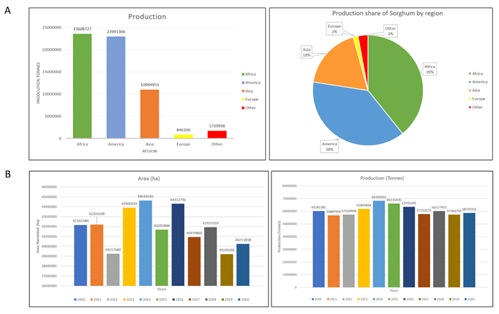Sorghum plant: Characteristics, Importance, Distribution and Uses

This post is also available in:
This post is also available in:
![]() Español (Spanish)
Español (Spanish) ![]() हिन्दी (Hindi)
हिन्दी (Hindi) ![]() Ελληνικά (Greek)
Ελληνικά (Greek)
Sorghum [Sorghum bicolor (L.) Moench], the fifth most important cereal crop in terms of production and planting area globally.
It is a key food crop grown in various countries in South Asia, Africa, and Central America (Ingle et al., 2023). It is mainly grown in marginal and stress-prone tropical and subtropical environments known as semi-arid regions.
Common names of Sorghum in different countries
In West Africa, sorghum is known as guineacorn, dawa, or sorgho; in Sudan, durra; in Ethiopia and Eritrea, mshelia; in East Africa, mtama; in southern Africa, kaffircorn, mabele, or amabele; and in the Indian subcontinent, jowar, jwari, jonna, cholam, or jola (Bantilan et al., 2004).
Sorghum types, characteristics, uses, and time of cultivation
Sorghum is primarily cultivated for animal feed in the United States, Australia, and South America, whereas it is primarily grown for human food in Africa and India. Sorghum is farmed in India during two seasons: kharif (or rainy) and rabi (post-rainy). Rabi is sown between September and the end of October.
It is a C4 crop; hence, with low input requirements, it gives a high net return. Sorghum is more resilient to adverse climatic conditions and performs well under water deficits and high-temperature regions. In India, sorghum grown during the rainy season is mostly used as feed since the grain is frequently wetted from rain during harvesting, and the grain quality suffers from mold. However, because of its high grain quality, postrainy sorghum is largely utilized as a food crop. It also serves as a major source of fodder, particularly during dry seasons, and is an essential crop in terms of food security.
The majority of rabi sorghum varieties are durra or durra intermediates, whereas the kharif cultivars planted are caudatum and kafir races (Reddy et al., 2003). The National Bureau of Plant Genetic Resources (NBPGR) with 26,330 germplasms collection (as on June 2023), and the International Crops Research Institute for the Semi-Arid Tropics (ICRISAT) with 42,352 germplasms (as on August 2021); collected most germplasm samples.
In terms of breeding, kafir, caudatum, and durra, which have yield-enhancing genes, have been widely used in breeding programs around the world. Despite some significant changes in both environments and cultural norms, rabi sorghum grown in India is like sorghum grown on residual moisture in other parts of Africa. However, there are two significant differences: African postrainy sorghums are cultivated in low soil fertility circumstances because they are cropped on receding flood plains after burning vegetation, and low plant density is used.
Area, Production, and Productivity of Sorgum
Sorghum yield and factors that affects it
Sorghum is highly adapted to hot and dry (semi-arid) agroecology systems, where other food grains are difficult to cultivate. Because sorghum is grown in drought-prone areas, it is grown with minimal inputs; in conditions of low soil fertility; under rainfed conditions with erratic and insufficient rainfall using traditional cultivars that are poor yielders; and is also subject to a variety of disease and pest problems that affect crop yields (Rai et al., 1999). The lower average yields are caused mostly by the hot, dry conditions in which sorghum is produced rather than by the plant’s inherent capability. Sorghum, on the other hand, has excellent yield potential, equivalent to rice, wheat, and maize (House, 1985).
Sorghum has yielded up to 11,000 kg/ha at the field level, where moisture is not a limiting issue, with average yields ranging from 7000 to 9000 kg/ha. Under improved management conditions, yields of 3000 to 4000 kg/ha are produced in traditional sorghum-cultivating areas, declining to 300 to 1000 kg/ha when moisture and soil fertility become limiting factors (House, 1985).
Sorghum is widely cultivated in more than 100 countries around the world. The top 10 sorghum producers include the USA, Sudan, Mexico, Nigeria, India, Niger, Ethiopia, Australia, Brazil, and China. These countries combined contribute about 77% of world sorghum production. The global average sorghum yield in 2018/19 was ~1.49 MT/ha. It is cultivated over 45.38 million ha globally, which accounts for 6.37 million tons of grains (FAO 2018, Hao et al., 2021). For reference, please follow Figure 1.

Figure 1: Area, Production, and Productivity of sorghum worldwide. In figure A. indicates the top continent contributing sorghum production and production share of sorghum by region, whereas B. shows showing area (ha) and production (tonnes) of sorghum for the last 10 years (FAOSTAT, 2018).
Uses of Sorgum
Fifty-five percent of the sorghum grain harvest is used for direct food consumption, usually as porridge (thick or thin) and flatbread. Especially in Australia and the Americas, it is a major source of feed grain (33%). Dry feed made from stover is particularly useful in Asia during the region’s dry season. Sorghum’s rapid growth, high green fodder output, and high quality make it a promising fodder resource. Sweet sorghum has recently emerged as a significant biofuel crop, expanding its already impressive list of uses to include food, feed, fodder, fuel, and fiber. That is why people generally refer to it as a ‘Smart Crop or Star Crop’ Green sorghum plants and crop wastes are used for construction and as a cooking fuel, especially in arid regions (Chandel & Paroda, 2000). Sorghum is also used to make paper and cardboard, jaggery, and ethanol.
The industrial potential of sorghum as a raw material source is substantial. Sorghum’s use in the industry makes growing it worthwhile for subsistence farmers. Alcoholic beverages, malt, beer, liquids, gruels, starch, adhesives, core binders for metal casting, mineral processing, and grits used as packaging are only some of the many industrial uses for grain.

Image 2: Various uses of Sorghum. A. Alcoholic beverage; B. Jowar Roti (flatbread); C. Sorghum Cake; D. Sorghum biscuits; E. Green forage for animals; F. Dry fodder; G. Sweet sorghum syrup. Sorghum which is especially bred, is usually used for different uses.
Nutritional value of Sorghum
Sorghum grain (a 100g portion) has approximately 329 kcal and:
- 10.4g protein
- 5–15g sugar
- 32–57g starch
- 6.7 g fiber
It is relatively rich in micronutrients, and so 1 kg of sorghum grain has:
- Iron (35–54 mg),
- Zinc (14–35 mg),
- Phosphorus (379–500 mg),
- Ca (20–44 mg),
- K (115–256 mg),
- Mn (10–24 mg),
- Na (12–54 mg), and
- Mg (750–1506 mg)
(Shegro et al., 2012, Ingle et a., 2023)
Tannins in red-grained sorghums provide antioxidants that protect against cell damage, a significant cause of disease and aging. The protein and starch in sorghum grain are comparably slowly digested than other cereals. This characteristic is highly beneficial for persons with diabetes; consequently, sorghum is called health food. Sorghum is a viable alternative to wheat flour for persons with celiac disease, as the starch from sorghum grain is gluten-free.
References:
FAO (2018) FAOSTAT. Food and Agricultural Organization, Rome. http://fao.org/faostat/en/#home.
Ingle K, Moharil M, Gahukar S, Jadhav P, Ghorade R, Thakur, N, Kasanaboina K, Ceasar SA. Assessment of Cytomorphological Differences in Sorghum Fertility Restoration. Agriculture 2023, 13, 985. https://doi.org/10.3390/agriculture13050985.
Bantilan, M.C.S., Deb, U.K., Gowda, C.L.L., Reddy, B.V.S., Obilana, A.B., Evenson, R.E., 2004. Introduction. In: Bantilan, M.C.S., Deb, U.K., Gowda, C.L.L., Reddy, B.V.S., Obilana, A.B., Evenson, R.E. (Eds.), Sorghum Genetic Enhancement: Research Process, Dissemination, and Impacts. International Crops Research Institute for the Semi-Arid Tropics, Patancheru, Andhra Pradesh, India, pp. 5–8.
Hao, H., Li, Z., Leng, C. Lu, C., Luo, H, Liu, Y., Wu. X., Liu, Z., Shang, L. and Jing H. 2021. Sorghum breeding in the genomic era: opportunities and challenges. Theor. Appl. Genet. 134, 1899–1924. doi: https://doi.org/10.1007/s00122-021-03789-z.
Reddy, B.V.S., Sanjana, P., Ramaiah, B., 2003. Strategies for improving post-rainy season sorghum: a case study for landrace hybrid breeding approach. Paper presented in the Workshop on Heterosis in Guinea Sorghum, Sotuba, Mali, pp. 10–14.
Rai, K.N., Murty, D.S., Andrews, D.J., Bramel-Cox, P.J., 1999. Genetic enhancement of pearl millet and sorghum for the semi-arid tropics of Asia and Africa. Genome. 42, 617–628.
House, L.R., 1985. A Guide to Sorghum Breeding, second ed. International Crops Research Institute for the Semi-Arid Tropics, Patancheru, India.
Chandel, K.P.S., Paroda, R.S., 2000. Status of plant genetic resources conservation and utilization in Asia-Pacific region – Regional synthesis report Asia-Pacific Association of Agricultural Research Institutions. FAO Regional Office for Asia and the Pacific, Bangkok, Thailand, 158 p.
Krishnananda Ingle, Niranjan Thakur, M. P. Moharil, P. Suprasanna, Bruno Awio, Gopal Narkhede, Pradeep Kumar, Stanislaus Antony Ceasar, Gholamreza Abdi. 2023. Current Status and Future Prospects of Molecular Marker Assisted Selection (MAS) in Millets. In: Pudake, R.N., Solanke, A.U., & Kole, C. (Eds.). (2023). Nutriomics of Millet Crops (1st ed.). CRC Press. https://doi.org/10.1201/b22809. eBook ISBN 9781003275657.
Shegro, A., Shargie, N.G., van Biljon, A., Labuschagne, M.T., 2012. Diversity in starch, protein and mineral composition of sorghum landrace accessions from Ethiopia. J. Crop Sci. Biotechnol. 15 (4), 275–280.
https://fdc.nal.usda.gov/fdc-app.html#/food-details/169716/nutrients









































































